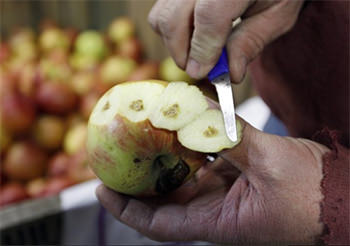IPM for the Brown Marmorated Stink Bug: Part 3
 |
| H. halys damages apples. (Courtesy J. Oberg, Md. Dept. Ag.) |
Organic Home Gardens
H. halys will eat tomatoes, corn, beans, and other garden vegetables. It will also feast on apples, peaches, and pears. Shade trees and roses are part of the menu. A list of 170 host plants can be found at the website StopBMSB.org. If there are large populations overwintering in your neighborhood, you may have to use row covers. Row covers of lightweight polyester or polypropylene will protect crops, but you will have to remove them to allow pollination (Nielsen and Hamilton 2009a; Ingels and Varela 2014).
Fruit tree protection is difficult, but BMSB prefers to fly up to the trunk of a tree, then walk up the trunk into the canopy (Leskey et al. 2012c). Sticky barriers around the trunk might stop nymphs and adults from climbing. Applying a 1 ft wide (30 cm) band of natural pyrethrins around the trunk might also prevent colonization. Ultimately, this approach may fail if adults adapt their behavior and fly directly into the canopy.
Destroy egg masses on the underside of leaves starting in June. Hand pick bugs and drop into soapy water or use a hand held vacuum cleaner to remove them from plants (Ingels and Varela 2014).
As usual, providing floral resources for natural enemies such as lacewings, parasitoids and ladybugs to encourage biocontrol is worthwhile (Quarles 2014a).
Box B. Aggregation Pheromones
A late season attractant for H. halys is the aggregation pheromone of the related stink bug, Plautia stali. This pheromone, methyl (E,E,Z)-2,4,6 decatrienoate (MDT), is useful for late season monitoring and mass trapping of H. halys. The pheromone also attracts other stink bugs, and acts as a kairomone, attracting stink bug natural enemies, such as tachinids and wasps (Cottrell et al. 2014; Aldrich et al. 2009; Aldrich et al. 2007; Khrimian et al. 2008). The P. stali pheromone (MDT) is used in the commercial pyramid trap sold by AgBio (see Resources).
Addition of murgantiol (10,11-epoxy-1-bisabolen-3-ol), the aggregation pheromone of the harlequin bug, Murgantia histrionica, makes the P. stali pheromone more attractive to BMSB earlier in the season. Sterling Intl. (see Resources) uses this combination for a commercial monitoring trap (Zhang et al. 2013; Zhang et al. 2014ab).
Natural Pheromone
The USDA has recently isolated the true aggregation pheromone secreted by H. halys adult males. A major component is (3S,6S,7R,10S)-10-11-epoxy-1-bisabolen-3-ol (SSRS). This is related to 1,10-bisaboladien-3-ol (zingiberenol) which occurs in ginger, Zingiber officinale (Weber et al. 2014).
A minor component is (3R,6S,7R,10S)-10,11-epoxy-1-bisabolen-3-ol (RSRS). The SSRS to RSRS ratio in the natural pheromone is 3.5 to 1. Donald Weber of the USDA tested the H. halys pheromone and found mixtures of these two components attract and capture both H. halys adults and nymphs (Weber et al. 2014).
Addition of the H. halys pheromone to MDT is synergistic, and the combined mixture (COMB) is attractive throughout the year. The combined lure catches 3–4 times more adults and 2–4 times more nymphs than MDT alone. COMB is attractive to spring adults, fall adults, and nymphs. Field tests showed the first H. halys adults appeared in April, and largest numbers of adults and nymphs were found in August (Weber et al. 2014).
COMB makes it possible to monitor early season populations, establish economic thresholds for IPM, implement mass trapping, and produce attract and kill formulations. The all-season attractant is a giant step toward effective, reduced risk IPM management of BMSB.
Pheromone Traps in Gardens
Pheromone traps (see Resources) may give early warning, but if populations are large, trap spillover may lead to plant damage. Sargent et al. (2014) found that pheromone traps led to increased bug colonization and increased damage in Maryland tomatoes. Traps were placed near tomato plants. About 300 bugs were caught in each trap, but bugs aggregated near the trap, damaging plants nearby and up to 6 m (18 ft) away.
If you use pheromone traps in your garden, you should space them away from desirable plants. The traps will give you early warning, but you must be prepared to vacuum up the trap spillover, or kill the bugs with least-toxic pesticides such as (Azera®).
House Invasions
Brown marmorated stink bugs are rude guests, as they eat your garden and then move in with you. Some houses have seen more than 25,000 bugs invade. These bugs fly toward lights, colliding with people. Fortunately, the bugs do not reproduce or feed while overwintering. They do not bite or carry diseases, but they produce unpleasant smells when crushed, and fill a house with excrement. Proteins associated with the bugs can cause allergies (Inkley 2012; Mertz et al. 2012).
Reproduction is prolific. If your house is invaded by 25,000 H. halys, this group of bugs could produce a summer population of almost three million in the immediate vicinity of your home (Lee et al. 2013; Kawada and Kitamura 1983).
Overwintering bugs like to hide in dark, tight places. Attics are favorite hideaways. Inkley (2012) found about 60% of the invading population was in the attic. The rest were captured in the living space. Bugs may hide in cracks and crevices along baseboards, door and window trim, and in light fixtures (Toyama et al. 2011; Ingels and Varela 2014).
Exclusion Is Best
The best approach is exclusion. Pay especial attention to the side of the house facing the sunset. Caulk up all holes, and make sure that window screens fit tightly. Pay attention to sealing around window air conditioners. Cover attic and foundation vents with screens. Make sure the chimney is protected with a screen. Weather-strip doors, and make sure each one has functional door sweep (Ingels and Varela 2014).
In Japan, boxes filled with straw, paper, or straw mats are used as traps outside to attract overwintering bugs. They also use special “slit” traps of layered pieces of plywood. Bugs crawl into the slits cut between the boards and are trapped. One 90 x 90 cm (36 by 36 in) slit trap placed on the ground trapped 2,693 bugs (Watanabe et al. 1994).
Near complete exclusion was achieved by covering exterior walls with 1 cm (0.4 in) mesh netting treated with pyrethroids. DEET repellant around windows also helped exclude bugs (Watanabe et al. 1994). DEET also repels the ladybug, Harmonia axyridis, another structural invader (Riddick et al. 2004). In the U.S., pheromone traps are available for use outside that attract overwintering bugs, reducing the number of invaders (see Sterling Resources).
Do Not Use Pesticides Inside
If they get inside your living space, do not use foggers. Any that you kill will just be replaced by others crawling from wall voids. If pesticides are applied to kill populations in wall voids, large numbers of dead bugs may attract flies and carpet beetles (Jacobs 2014).
The best approach is to use a vacuum cleaner to remove them from your living space. Bugs can give a vacuum cleaner an odor, so having an old one just for this purpose is the best idea. Bugs can be killed by dropping them into soapy water. Live bugs should not be dropped into garbage. Bugs inside are attracted to a light trap. These are commercially available (see Sterling Resources). Or you can use a desk lamp over a pan of soapy water as a trap (StopBMSB.org 2014).
Conclusion
The BMSB invasion will likely increase and spread. The invasive pest is favored by prolific reproduction, wide host range, lack of specific natural enemies, cold tolerance, global warming, and overwintering skills. There can be a short lag time between initial invasion and population explosions. Monitoring is extremely important, and pheromone monitoring can now give an early warning.
Biological control of eggs is a promising approach. Predators in the U.S. are effective, but parasitoids have not adapted. Importation of a more effective egg parasitoid may be necessary. Biopesticides are available that can help manage populations without killing bees. Special techniques such as banding trees, using aggregation pheromones in attract and kill formulations, and spraying perimeters of row crops and orchards can reduce amount of pesticide applied. Overwintering traps and efficient exclusion can reduce the impact of BMSB inside houses. The brown marmorated stink bug is not going to go away, but IPM techniques can limit the damage.
Acknowledgment
The author wishes to thank Erin Berg for helping with the research on this article.
William Quarles, PhD, is an IPM Specialist, Managing Editor of the IPM Practitioner, and Executive Director of the Bio-Integral Resource Center (BIRC). He can be reached by email at birc@igc.org.
 |
Page 3 of 4 |  |
